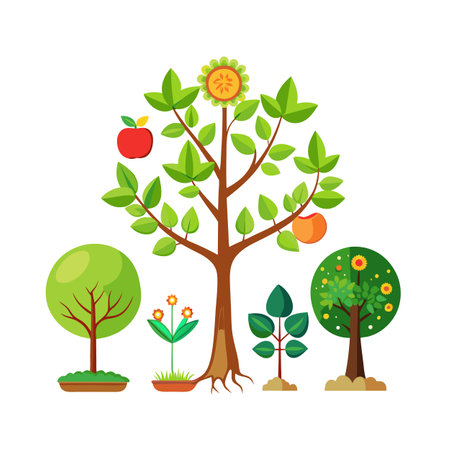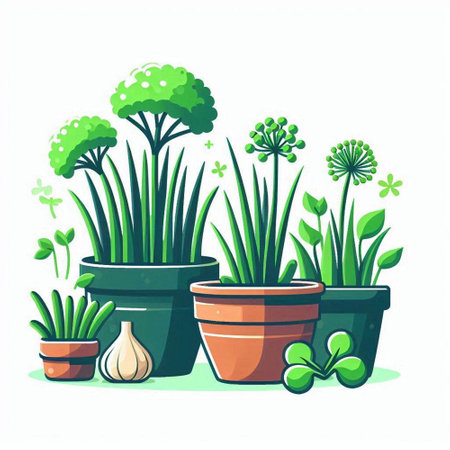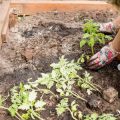1. Introduction to Biodiversity in Organic Gardens
When you step into a thriving organic garden, there’s an unmistakable sense of harmony—a natural balance where every plant, insect, and bird plays its part. This symphony of life is what we call biodiversity. In the context of organic gardening, especially within the diverse landscapes of America, biodiversity means more than just variety; it’s about fostering a resilient ecosystem that supports healthy plants and nurtures wildlife.
What Is Biodiversity?
Biodiversity refers to the variety of living organisms within a specific area. In an organic garden, this includes everything from native grasses and wildflowers to pollinators like bees and butterflies, as well as beneficial soil microbes and even visiting birds. Each species contributes to the garden’s overall health, creating natural checks and balances that help keep pests under control and encourage robust growth.
The Unique Importance in American Gardens
America’s landscapes are rich with regional diversity—from the rolling meadows of the Midwest to the sun-baked gardens of California and lush Southern backyards. Embracing local biodiversity honors these unique environments while promoting sustainability. By choosing native plants and encouraging a range of wildlife, gardeners help preserve America’s natural heritage and create spaces that feel authentically connected to their surroundings.
Why Biodiversity Matters in Your Organic Garden
| Biodiversity Benefit | How It Supports Your Garden |
|---|---|
| Pest Control | Attracts beneficial insects that manage harmful pests naturally. |
| Soil Health | Diverse plant roots and microbes enrich and stabilize the soil. |
| Pollination | Supports a steady supply of pollinators for fruits, veggies, and flowers. |
| Resilience | A varied ecosystem is better equipped to handle weather extremes and diseases. |
| Cultural Connection | Celebrates local flora and fauna, connecting gardens to American landscapes. |
Bringing It All Together: A Living Tapestry
An organic garden rich in biodiversity feels alive—each element woven together like a living tapestry. From songbirds nesting in native shrubs to ladybugs patrolling vegetable beds, every layer adds beauty and function. By nurturing this diversity, American gardeners create not just beautiful spaces but also vibrant habitats that support life in all its forms.
2. Native Plants: Foundation of Local Biodiversity
When designing an organic garden that truly thrives, incorporating native plants is a powerful way to nurture biodiversity right in your own backyard. Native plants are species that have evolved naturally in a particular region, making them perfectly adapted to the local soil, climate, and wildlife. By choosing these plants, you’re not just creating a beautiful landscape—you’re building a living ecosystem that supports pollinators, birds, and other creatures essential for a healthy garden.
Why Choose Native Plants?
Native plants play a unique role in sustaining local biodiversity. Unlike non-native or ornamental species, they provide the exact food and habitat that local insects, birds, and small mammals depend on. When you plant natives, you invite butterflies, bees, hummingbirds, and songbirds to make your garden their home. These visitors, in turn, help with pollination and natural pest control—making your organic garden more resilient and self-sustaining.
Benefits of Native Plants
| Benefit | Description |
|---|---|
| Support Pollinators | Provide nectar and pollen for bees, butterflies, and moths throughout the growing season. |
| Wildlife Habitat | Shelter and food for birds, beneficial insects, and small animals native to your area. |
| Drought Tolerance | Adapted to local rainfall patterns; require less watering than exotic species. |
| Pest Resistance | Less likely to attract invasive pests or need chemical treatments. |
| Soil Health | Deep roots stabilize soil and foster healthy microbial communities underground. |
Choosing Native Plants for Your Region
Selecting the right native plants depends on your local environment—think about sun exposure, soil type, and how much water your site naturally gets. For example, in the American Midwest, prairie grasses like Little Bluestem and wildflowers such as Purple Coneflower thrive beautifully. In California gardens, try California Poppy or Toyon shrub. Most state extension offices or native plant societies offer helpful lists tailored to your zip code.
Quick Tip: Plant Diversity Matters!
The more variety you include—from early spring bloomers to late fall seed producers—the more types of wildlife you’ll support year-round. Layer shrubs with groundcovers and tall perennials for a lush look that’s also ecologically rich.

3. Beneficial Insects and Wildlife
The Secret Helpers in Your Garden
When you step into a thriving organic garden, you’ll notice more than just lush plants and colorful flowers. Listen closely, and you’ll hear the gentle buzz of bees, the fluttering wings of butterflies, and the cheerful songs of birds. These creatures aren’t just visitors—they are essential partners in keeping your garden healthy and productive.
How Bees, Butterflies, and Birds Support Biodiversity
Bees are nature’s best pollinators. As they gather nectar, they spread pollen from flower to flower, helping fruits and vegetables grow strong. Butterflies not only add beauty but also assist with pollination. Birds eat pesky insects that could damage your crops, acting as natural pest control. Together, these species create a balanced ecosystem where every living thing plays a part.
Common Beneficial Wildlife in Organic Gardens
| Species | Main Benefit | Fun Fact |
|---|---|---|
| Bees | Pollination of flowers, fruits, and veggies | One out of every three bites of food depends on pollinators like bees! |
| Butterflies | Pollination and early warning for environmental health | Caterpillars may munch leaves, but adult butterflies help flowers flourish. |
| Birds | Pest control by eating harmful insects | A single chickadee can eat hundreds of caterpillars per day. |
| Lacewings & Ladybugs | Natural enemies of aphids and other pests | Lacewing larvae are called “aphid lions” because of their appetite for garden pests. |
Encouraging More Wildlife in Your Garden
- Plant native flowers to attract local bees and butterflies.
- Add birdhouses or feeders to invite songbirds.
- Create small water sources, like a shallow dish or birdbath.
- Avoid chemicals—organic methods keep wildlife safe.
The Power of Biodiversity
Diversity isn’t just beautiful—it’s practical. A mix of insects and animals keeps your garden resilient against pests and diseases. By welcoming a variety of helpful creatures, you’re supporting the entire web of life right in your backyard. The more diverse your garden guests, the healthier your organic garden will be!
4. Soil Life and Microbial Diversity
When it comes to organic gardening, the magic often happens below our feet. A thriving organic garden depends not just on the plants you see but also on a bustling world of organisms hidden in the soil. This underground community—teeming with bacteria, fungi, earthworms, nematodes, and other microbes—plays a crucial role in keeping your garden healthy, productive, and sustainable.
How Soil Organisms Support Organic Matter Breakdown
Diverse soil organisms work together to break down fallen leaves, plant debris, and organic matter. Bacteria and fungi are nature’s recyclers, converting dead material into valuable nutrients that plants can use. Earthworms and insects help by shredding larger pieces of organic matter and mixing them deeper into the soil, speeding up the decomposition process.
Main Roles of Soil Organisms in Organic Gardens
| Soil Organism | Main Function | Garden Benefit |
|---|---|---|
| Bacteria | Decompose organic matter, fix nitrogen | Release nutrients for plant growth |
| Fungi (Mycorrhizae) | Break down tough materials, form plant partnerships | Increase root nutrient uptake |
| Earthworms | Aerate soil, mix organic material | Improve soil structure and fertility |
| Nematodes & Insects | Feed on pests or decompose waste | Control harmful bugs and recycle nutrients |
Nutrient Cycling: Nature’s Fertilizer System
The diversity of soil life ensures efficient nutrient cycling—meaning nutrients are constantly being broken down, transformed, and made available to plants. For example, certain bacteria convert atmospheric nitrogen into forms that plants can absorb—a process called nitrogen fixation. Other microbes unlock phosphorus and potassium from soil minerals. By fostering this rich microbial community, your garden gets a steady supply of natural fertilizer without synthetic inputs.
Sustainable Garden Productivity Starts Below Ground
The health and productivity of your organic garden start with vibrant soil life. By encouraging microbial diversity through composting, mulching, avoiding chemical pesticides, and rotating crops, you build a self-sustaining ecosystem that supports strong plants year after year. Remember: when you care for your soil’s living community, you’re investing in the long-term success and resilience of your entire garden.
5. Companion Planting and Intercropping
Understanding the Power of Plant Partnerships
Companion planting and intercropping are time-honored gardening strategies that harness the natural diversity of plants to create a thriving organic garden. By carefully selecting which crops grow together, gardeners can boost plant health, manage pests naturally, and increase yields without relying on synthetic chemicals.
What Is Companion Planting?
Companion planting involves placing certain plants close to each other so they can benefit one another. Some plants repel pests, while others attract beneficial insects or provide shade and support. These pairings create a balanced ecosystem right in your backyard.
Popular Companion Plant Examples
| Plant | Best Companions | Benefits |
|---|---|---|
| Tomatoes | Basil, Marigold | Basil repels insects; marigold deters nematodes |
| Carrots | Onions, Chives | Onions mask carrot scent, confusing carrot flies |
| Cucumbers | Nasturtiums, Radishes | Nasturtiums attract aphids away; radishes deter beetles |
| Cabbage Family | Dill, Sage | Dill attracts predatory wasps; sage repels cabbage moths |
The Benefits of Intercropping
Intercropping is the practice of growing two or more crops together in the same space at the same time. This method maximizes garden productivity and makes better use of soil nutrients. With different root depths and growth habits, plants help each other thrive and reduce competition from weeds.
Simple Intercropping Ideas for Your Garden
- Corn, Beans & Squash (The Three Sisters): Corn gives beans a place to climb, beans fix nitrogen in the soil, and squash shades out weeds.
- Lettuce Under Tomatoes: Lettuce enjoys the cool shade provided by tomato plants as they grow taller in summer.
- Radishes with Carrots: Radishes mature quickly and loosen soil for slower-growing carrots.
How Companion Planting & Intercropping Support Biodiversity
Diverse plantings invite pollinators and beneficial insects while disrupting pest cycles. They also enrich the soil with a variety of root structures and organic matter. Embracing these design strategies not only leads to healthier plants but also fosters a vibrant garden ecosystem unique to every American backyard.
6. Garden Design for Year-Round Biodiversity
Designing your organic garden with biodiversity in mind isn’t just about planting a few different flowers—it’s about creating a living landscape that supports wildlife and keeps your garden thriving through every season. Here’s how you can structure your space for lasting beauty and ecological health, all year round.
Layered Plantings: Building Nature’s Architecture
Think of your garden like a mini forest, where different plants grow at different heights. Layering creates more habitats for birds, pollinators, and beneficial insects. Here’s a simple guide to structuring your garden layers:
| Layer | Examples | Biodiversity Benefits |
|---|---|---|
| Tall Canopy | Native trees (oak, maple, dogwood) | Nesting sites for birds, shade for understory plants |
| Shrub Layer | Blueberries, elderberry, native viburnum | Food and shelter for birds and insects |
| Herbaceous Layer | Bee balm, coneflower, milkweed | Nectar for bees and butterflies, color throughout the seasons |
| Groundcover | Creeping thyme, wild strawberry, clover | Weed suppression, habitat for beetles and ground-nesting bees |
| Vertical Elements | Trellised peas, pole beans, native vines like trumpet honeysuckle | Adds vertical interest, food sources for pollinators and hummingbirds |
Seasonal Interest: Keeping the Garden Alive All Year Long
A biodiverse garden should look—and feel—alive in every season. Choose plants that bloom or provide berries at different times of the year so pollinators always have something to eat and birds stick around even in winter. Here are a few ideas:
- Spring: Plant early-bloomers like serviceberry and crocus for emerging bees.
- Summer: Sunflowers and black-eyed Susans attract butterflies and provide seeds later.
- Fall: Goldenrod and asters feed migrating pollinators; native grasses offer seeds for birds.
- Winter: Evergreens give shelter; holly and winterberry provide food when pickings are slim.
Habitat Features: Welcoming Wildlife Home
Biodiversity thrives when you invite nature in. Incorporate features that offer food, water, shelter, and places to raise young. Here are some American favorites:
- Birdhouses & Bat Boxes: Hang them on mature trees or posts to support nesting.
- Piles of Branches or Logs: Create brush piles for sheltering birds, rabbits, and beneficial insects.
- Ponds or Birdbaths: Even a small water source will attract frogs, dragonflies, and thirsty songbirds.
- Mason Bee Hotels: These simple wood blocks with holes drilled in them make perfect homes for solitary native bees.
- Leave Some Leaves: Skip raking certain areas so butterflies and fireflies can overwinter safely beneath the leaf litter.
Your Year-Round Biodiverse Garden Awaits
No matter your space—from a backyard oasis to a sunny balcony—layered plantings, seasonal variety, and welcoming habitat features will turn your garden into an ever-changing sanctuary teeming with life. By embracing these design principles rooted in American gardening traditions, you’ll nurture not just your plants but the entire ecosystem right outside your door.
7. Cultivating a Thriving, Sustainable Future
Empowering Your Backyard for Biodiversity
Bringing biodiversity into your organic garden is not just about beauty—it’s a powerful way to create a healthier, more resilient ecosystem right outside your door. Every gardener can make a difference by taking practical steps and connecting with community resources designed to support both people and the planet.
Simple Steps to Boost Biodiversity
| Action | How It Helps |
|---|---|
| Plant Native Species | Attracts local pollinators, supports wildlife, and thrives with less water or chemicals. |
| Create Habitat Layers | Mix tall trees, shrubs, flowers, and groundcovers to offer shelter for different creatures. |
| Avoid Pesticides | Keeps pollinators and beneficial insects safe while letting natural pest control happen. |
| Add Water Sources | Birdbaths or small ponds give bees, butterflies, and birds a place to drink and rest. |
| Leave Some Wild Spaces | Piles of brush or leaves provide homes for helpful insects and small animals. |
Community Resources for Gardeners
You don’t have to do it alone! Across the United States, many organizations are eager to help you succeed in creating a biodiverse organic garden. Here are some valuable places to start:
- Local Cooperative Extension Offices: Get free advice on native plants and soil health tailored to your region.
- Native Plant Societies: Join workshops or plant sales to learn which species thrive locally.
- Community Gardens: Meet fellow gardeners, swap seeds, and share tips on eco-friendly growing practices.
- The National Wildlife Federation’s Certified Wildlife Habitat Program: Learn how to turn your yard into a welcoming space for wildlife—and even earn official certification.
- Online Gardening Forums: Connect with passionate growers on platforms like Garden.org or local Facebook groups for support and inspiration.
Your Garden Matters
No matter the size of your plot—whether it’s a city patio or sprawling suburban lawn—every effort counts. By nurturing biodiversity, you’re helping ensure cleaner air, healthier soils, more pollinators, and a vibrant landscape that reflects the best of American gardening spirit. Start small, stay curious, and watch as your backyard becomes part of something much bigger: a thriving, sustainable future for all.


